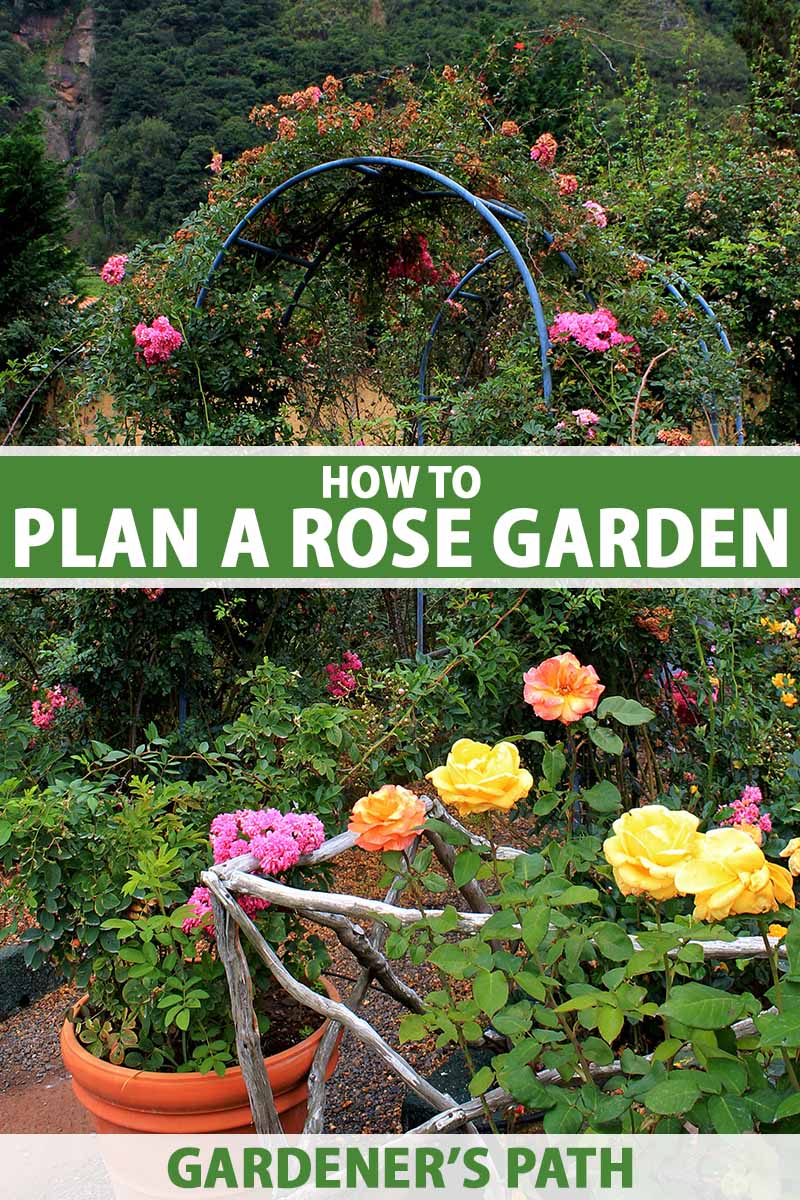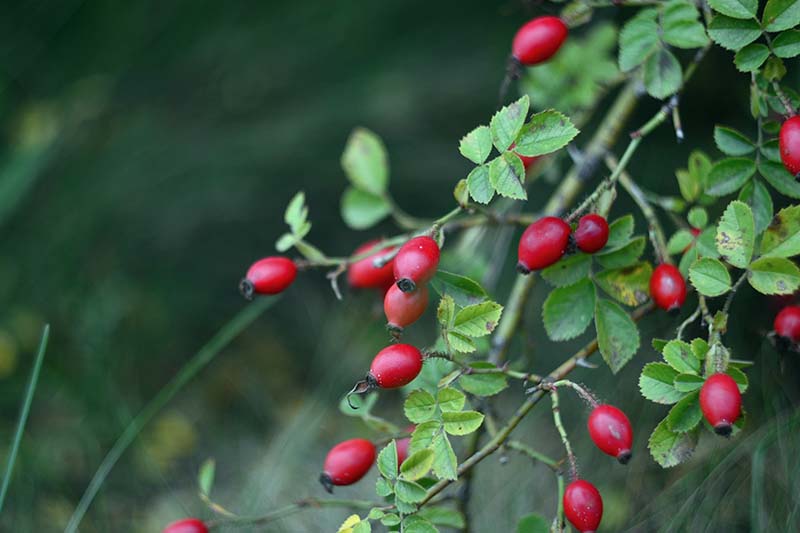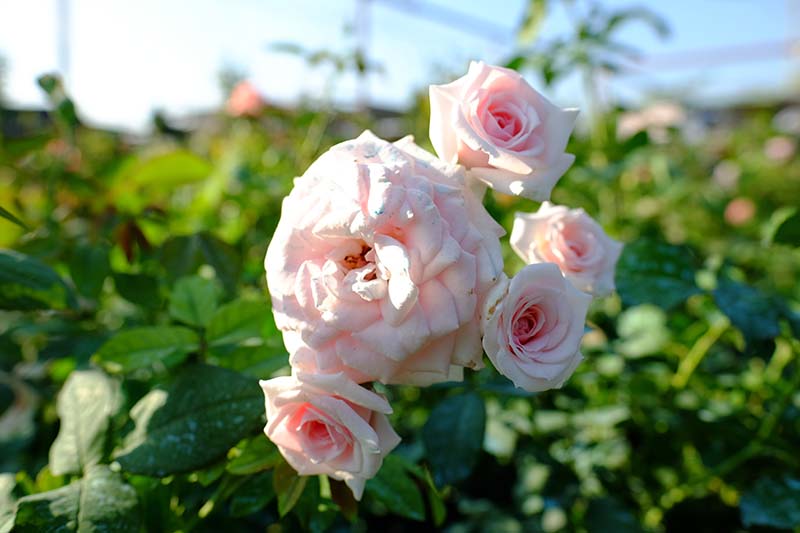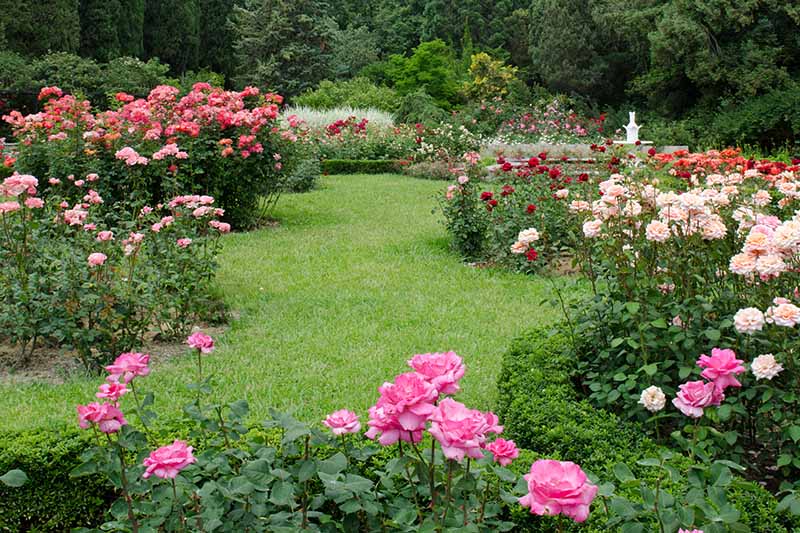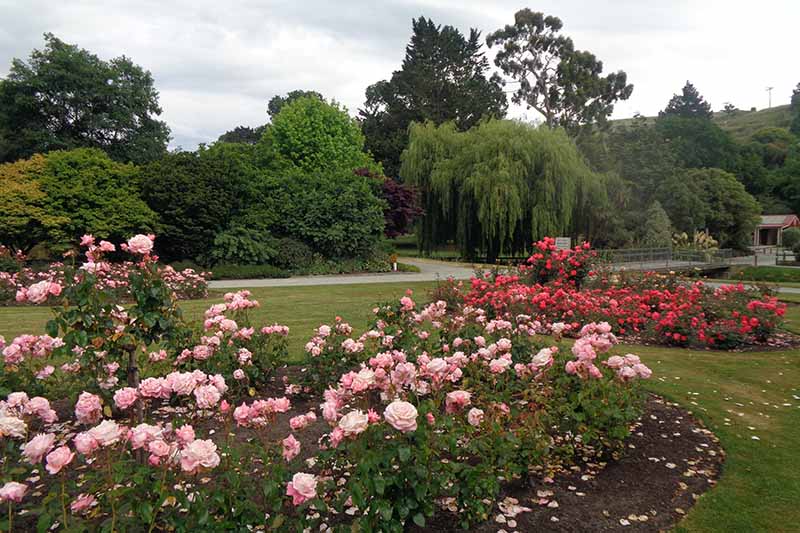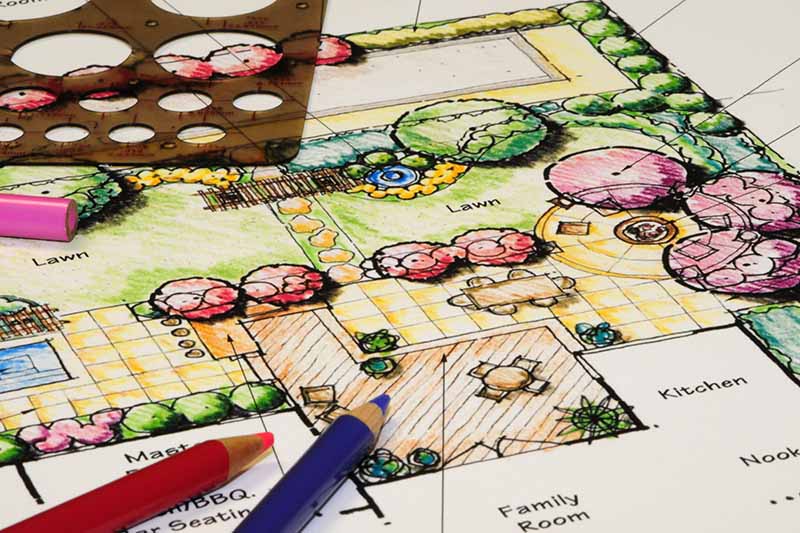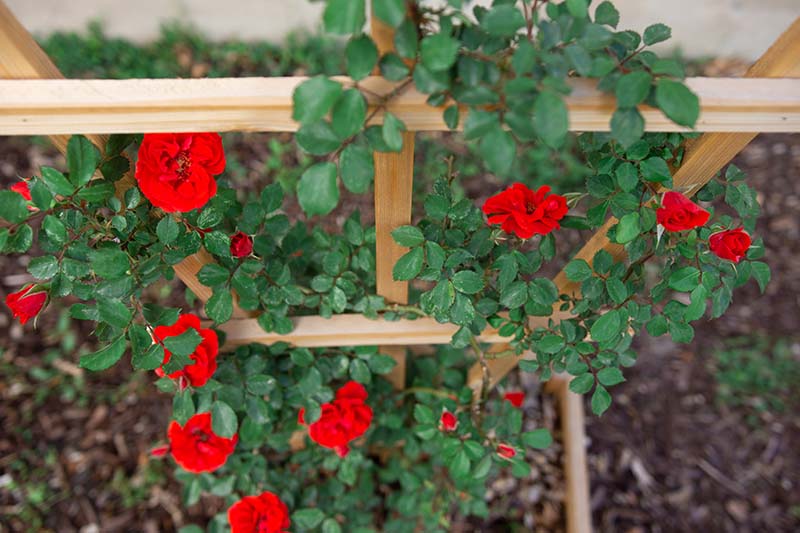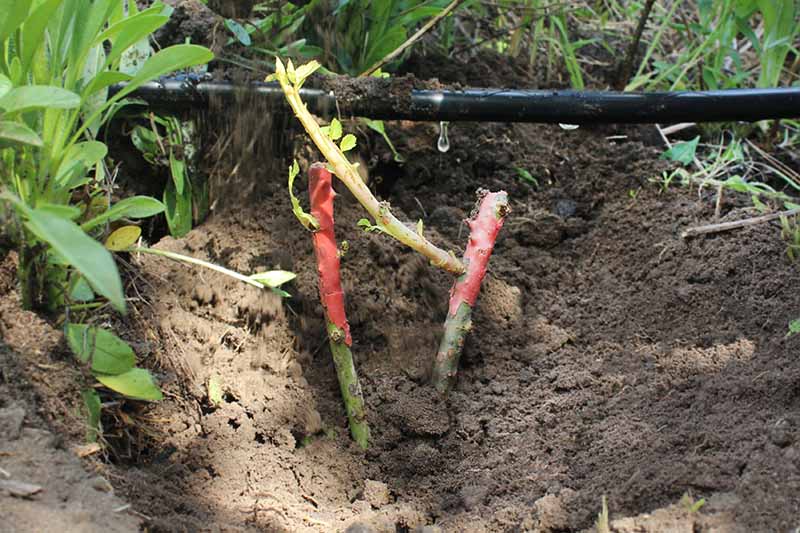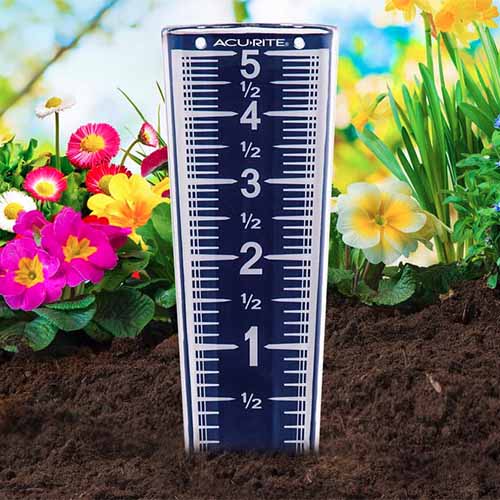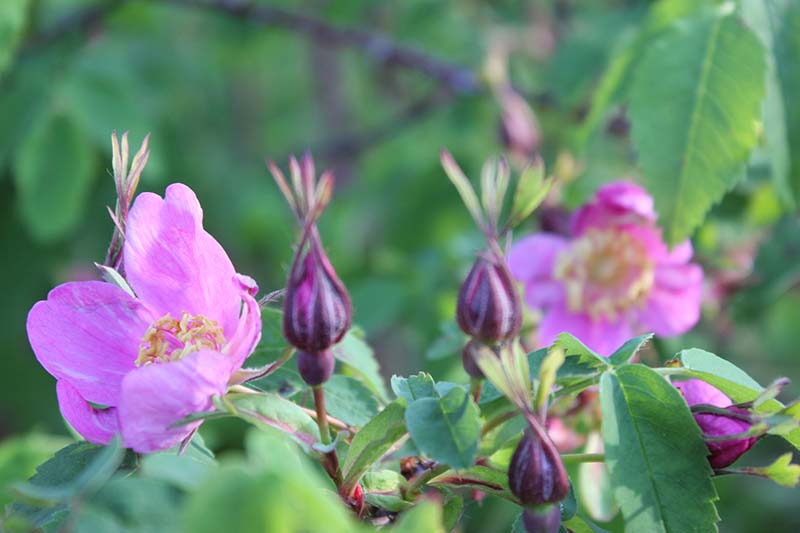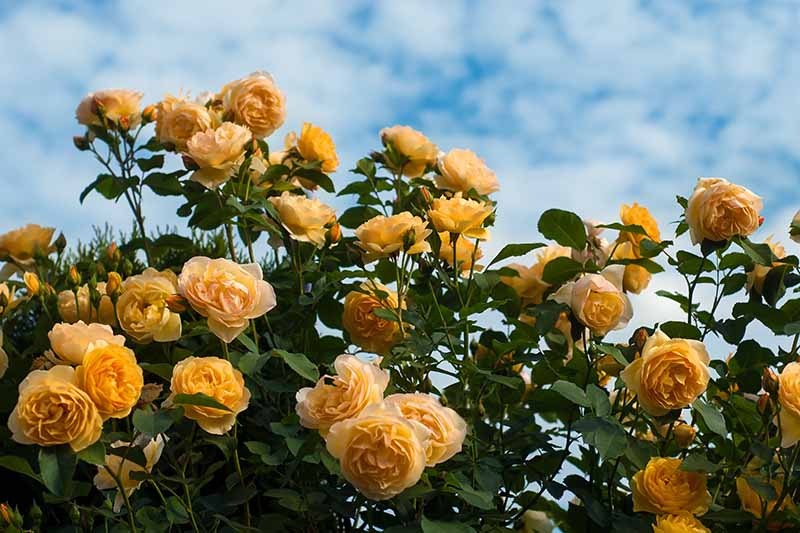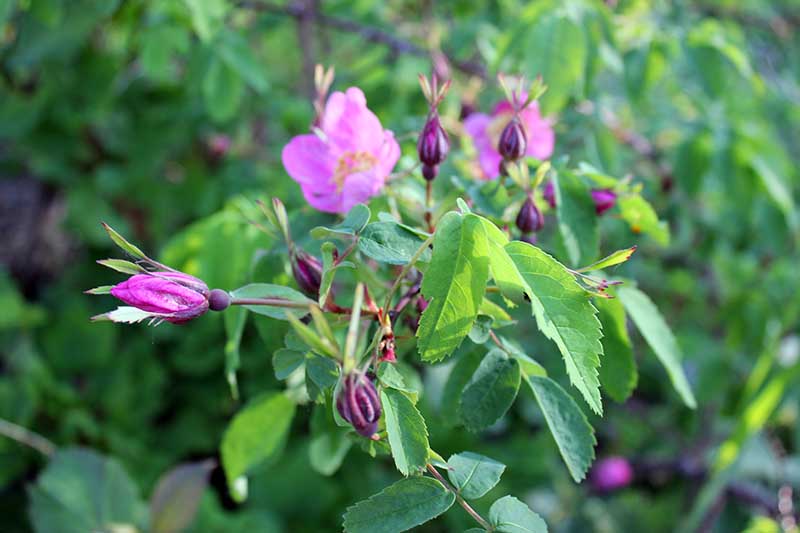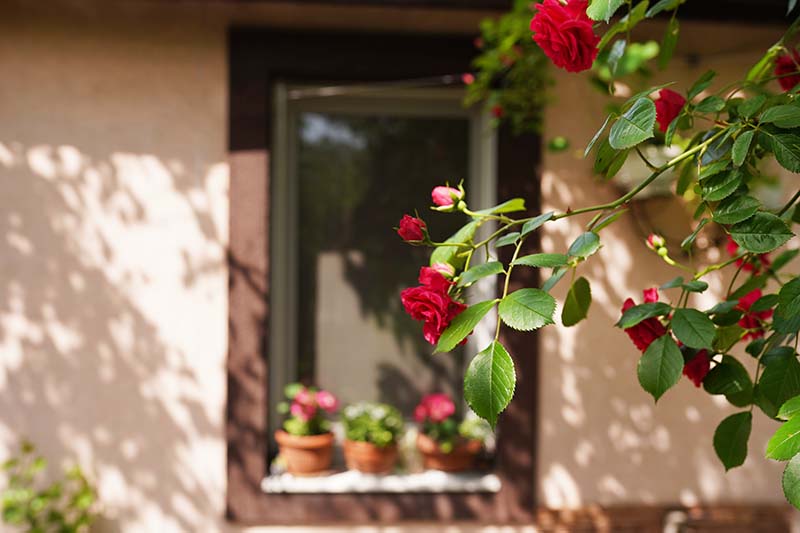The scent! The sight! The color! Everything about that experience was magical, and you’d better believe I stopped to smell the flowers. Several times. Since then, I’ve helped people in my family cultivate rose gardens, and I’m here to help you, too. We link to vendors to help you find relevant products. If you buy from one of our links, we may earn a commission. How do you start? Do you have to create something as lofty as the archway that I saw at the Butchart Gardens, or the carefully cultivated garden space in your local botanic garden? In this guide, we’ll answer these questions and help you get started with planning your own sweet-smelling rose garden.
What Qualifies as a Rose Garden?
If you’ve never grown roses before, or want to learn more about this timelessly popular genus of plants, check out our guide to growing roses. While these flowers are notorious for being hard to care for, they’re really no more difficult to grow than other dazzling perennials like delphiniums, hydrangeas, and peonies. You can also think of growing them like you’d think of growing other shrubby or sprawling plants in the Rosaceae family, like blackberries or raspberries. They require similar care – and many cultivars produce edible fruits called “rose hips” that you can harvest and turn into jelly. There are dozens of heirlooms, hybrids, and cultivars available to choose from. Newer cultivars tend to have better disease resistance than hybrid teas, for example. Plus, some cultivars shine in small growing spaces like containers. This means just about anyone can grow a garden filled with Rosa plants. Rose gardens typically feature various types of specimen plants. Sometimes they just include Rosa species, and other times they include other plants, too. They can have various shapes, styles, and structures that help to feature types with different growing habits – think arbors, geometric or natural shapes and styles, beds planted with shrubs, and so on.
How to Plan a Rose Garden at Home
The sky’s the limit when it comes to what you can do. But developing a plan is crucial to the success of your garden, so let’s get started.
Choose a Location
The first thing to consider is where you want to put your garden. Whether you grow the flowers in containers, raised beds, window boxes, or in-ground beds, there are a few important requirements to note. They must have:
Six to eight hours of sunlight every dayOrganically rich, loamy, well-draining soil with a pH between 6.0 and 6.5A protected area – for example, don’t plant roses directly under the eaves where they’ll get pummeled with rain in the summer or icicles in the winter
Keeping the above considerations in mind, think about what type of look you want to achieve. Do you want the plants to climb a trellis or archway? How tall do you want the roses to grow, and how much do you want them to spread? Will you place a bench somewhere within the garden so you can sit and relax? How will you access the plants for pruning, watering, and maintenance? Do you want to mix other plants – such as foxgloves, geraniums, and lavender – in with the roses to help ward off pests and keep things varied, or do you want various types of Rosa plants to be featured on their own? Are you drawn to a formal, manicured look, or a more informal, natural look? What style of garden will best match the exterior of your house? Take a look at examples in gardening books, magazines, and other resources that inspire you. Visit nearby public gardens, and ask that friend with the splendid mature garden to let you come study it and tell you about it. Take notes on her process. Jot down the ideas that you’d love to incorporate in your own garden in your gardening journal. Even if you have the most rudimentary drawing skills, try sketching out what you want your garden to look like. The sketch is also a smart place to note the areas in your yard that get six to eight hours of sunlight, and any other details you want to keep in mind as you work.
Prepare Your Chosen Spot
Once you’ve sketched out your plans, you’ll have a rough idea of where your garden will be placed. So let’s talk about size. Since you’ve already taken a look at other gardens and know what types you want to grow, think about the general size of each type that you’ve seen. Hybrid teas, floribundas, and small shrubs grow about two to six feet tall and wide. Grandifloras and large shrubs typically reach six to 10 feet tall and wide. Miniatures only grow to about 15 to 30 inches in height and spread. Large-flowered climbers spread four to five feet, but they can grow anywhere from eight to 15 feet tall. Take a look at your budget and your available space, and then decide about how many roses of which general sizes you want to plant. Graph paper can help with this. It’s important to give the individual plants within your garden adequate space – the maximum spread is a good benchmark for this. Four large floribundas, for example, would require about 36 square feet of space per plant, and at least 144 square feet total. Four smaller ones with a more compact habit might fit into 16 square feet of space. Keep the distance to nearby structures like walls and fences in mind as well, for plant health and to maintain proper airflow. Planting right up against houses, fences, and so on, as well as planting too closely to other types of flora, can block sunlight and cause moisture on the leaves to fail to evaporate quickly, making plants more prone to fungal disease. Now is also a good time to take a look at the soil in your chosen planting area. Conduct a soil test to assess the nutrients and pH level. The pH should be between 6.0 and 6.5, and the soil should be rich, well-draining, and loamy. If it’s too compact or clay-like, you may need to add sand and compost to improve the soil. Amend your soil to modify the pH if needed. Wood ash can help raise the pH, while aluminum sulfate or sulfur can help lower it. Place any structures you’ve picked out – like an archway or bench – in the area where you’ll be planting.
Create a Maintenance Schedule
Your location is almost ready to go! Before you pick out your plants, though, consider how you will care for them. Roses like soil that’s moderately moist, and it’s best to avoid watering the flowers and foliage if possible. Write out your maintenance schedule in your gardening journal and add it to your phone’s reminders system. This will help you to keep your garden healthy once it’s planted. What about a rain gauge to keep an eye on how much precipitation your plants get from Mother Earth? AcuRite Rain Gauge A rain gauge like this one from AcuRite, available at the Home Depot, can help you avoid overwatering your plants. Get several bags of organic mulch ready, too. Roses prefer to have a two- to three-inch layer of mulch in place over the root surface area of each plant. This helps to retain moisture and keep weeds out. Neptune’s Harvest Fertilizer When you see new growth on your newly planted shrubs, you should plan to apply a liquid fish and seaweed fertilizer, like this one from Neptune’s Harvest, available from Terrain. You’ll also want to plan to prune every fall or spring – set reminders in your phone so you don’t forget this important step. See our guide for the best rose pruning tips for more info. Now you’re just about ready to purchase some roses!
Select the Plants
Wait, wait! It’s not time to run to the nearest nursery just yet. But hang tight, because we’re almost there. First, consider the questions below and write the answers down on the back of your sketch.
1. Consider Your Hardiness and Maintenance Needs
When it comes to hardiness, there are three key points to take into consideration:
What is your growing zone?Does a plant’s pest and disease resistance matter to you?Do you prefer high or low maintenance roses?
The surest way to grow a rose garden that doesn’t thrive is to pick plants that aren’t suited to your growing zone. Most roses grow easily in USDA Hardiness Zones 6 through 9, with the pickings getting slimmer for those of us who live in Zones 3 through 5, or 10 and up. But we can grow them. We just have to choose the right ones. Since there are many ways to classify roses, it can be hard to figure out which types tend to be hardy, surviving light and heavy frosts, and which are tender, not able to survive even a light frost. Here’s a quick breakdown of the hardiness ranges according to market classification, which is commonly used by nurseries. The following is modified from a chart by Stephen L. Love, a community horticulture specialist with the University of Idaho Extension.
Hybrid tea: tenderFloribunda: tender to somewhat hardyGrandiflora: tenderMiniature: tender to somewhat hardyShrub: tender to hardyClimbing: tender to hardyHeirloom/old garden: tender to hardy
Obviously, there’s a ton of variation even within each classification, but this gives you a good starting point. If you live in Zone 3, for example, you can probably cross tea roses and grandifloras off your list. But new, cold hardy cultivars are being developed all the time. In our guide to hardy roses, we introduce 13 of the toughest blooms, chosen for their shade tolerance, disease resistance, and cold hardiness. Make sure you take a look at this roundup as you plan which cultivars to select. We’ve also got a super helpful guide to buying roses with winning tips like getting in touch with your state’s rose society to find high quality varieties that thrive in your area. When it comes to pest and disease resistance, heirloom and old garden varieties have excellent disease resistance and tend to be cold hardy, too. True heirlooms – varieties originally selected before 1867 – can be difficult to find, though, and a downside is that many only bloom once in a growing season. Newer, repeat-blooming series like the Knock Out® varieties are also known for their disease resistance, so it’s entirely possible to find something that suits all your needs. Even better, Knock Out® varieties are self-cleaning, which means the flowers drop after they’re spent and you don’t have to deadhead to keep them blooming all summer long. A downside? Self-cleaning varieties are sterile and don’t produce rose hips, so if you’re looking to harvest hips for jam, stay away from self-cleaners.
2. What Are Your Color, Use, and Growth Habit Preferences?
While color, use, and growth habit preferences are important, they’re secondary to hardiness. So once you’ve got a list of plants that grow well in your area and have the disease resistance and maintenance requirements you prefer squared away, it’s time to think about the fun stuff. I like to write down all the cultivars I’m considering based on what fits my hardiness zone, and then further narrow those plants down by color, growth habit, and my intended use. How will you use the flowers in your garden? If you want to dry the blooms as decoration, or you want long-stemmed varieties to cut and put in vases, you’ll need to choose an appropriate variety. Or maybe you’d rather not pick the flowers, but instead prefer for them to act as ground cover, or an awe-inspiring trellis climber. Think about what colors pop against the exterior of your home and any other structures you have in or near your rose garden. I have a red house, so I tend to love a combination of yellows and pinks. My in-laws in California have a sage-green home exterior against which they’ve planted a garden of splendid white blooms. When it comes to growth habits, consider the space you’ve allotted. Will you need climbers? Ground covers? Bushes? See our comprehensive guide to rose growth habits for a breakdown of these to further narrow down your list of plants to buy for your garden. Once you’ve got your list finalized, it’s time to go shopping! This is the best part, in my opinion. There’s nothing like the feeling of working outside all day, and then stepping back at the end of the day and gazing at your newly planted garden. Once you’re done, we’d love to see pictures. Please share them in the comments section below! You can also send us your questions throughout the planning process. We’re happy to help. For more tips to help you care for your beloved rose blossoms, don’t miss these guides:
How to Collect and Save Rose Seeds for PlantingHow to Winterize RosesHow to Identify and Treat Common Rose DiseasesWhy Are My Rose Leaves Turning Yellow?
